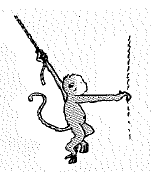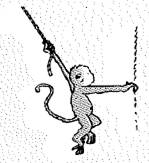
Concept explainers
A monkey hangs by a strand of rope and holds onto the zoo cage as shown. Since her arm holding the cage is horizontal, only the rope supports her weight. How does the tension in the rope compare with her weight?

To compare: The tension in the rope with the monkey’s weight.
Answer to Problem 40A
Tension in the rope is greater than the weight of the monkey.
Explanation of Solution
Given:
A monkey hanging on the rope as shown below.

Formula Used:
All forces applied on any object must be in equilibrium and constant.
Calculation:
When gravitational force is applied on the weight then it is equal to the opposing force that is vertical component of tension on the rope monkey is holding.
T is the tension in rope. W is the weight of monkey. R is the reaction force.
Horizontal Force:
Vertical Force:
Squaring both equations.
This suggests that tension in the rope is greater than the weight of the monkey.
Conclusion:
Thus, the tension on the rope is greater than the weight of the monkey holding the cage.
Chapter 2 Solutions
Conceptual Physics C2009 Guided Reading & Study Workbook Se
Additional Science Textbook Solutions
Campbell Essential Biology (7th Edition)
Genetic Analysis: An Integrated Approach (3rd Edition)
Applications and Investigations in Earth Science (9th Edition)
Human Anatomy & Physiology (2nd Edition)
Physics for Scientists and Engineers: A Strategic Approach, Vol. 1 (Chs 1-21) (4th Edition)
Human Biology: Concepts and Current Issues (8th Edition)
- 6. Is the true pendulum an example of SHM? Explain.arrow_forwardIn the circuit shown below & = 66.0 V, R5 = 4.00, R3 = 2.00, R₂ = 2.20 ₪, I5 = 11.41 A, I₁ = 10.17 A, and i̟ = 6.88 A. Find the current through R2 and R3, and the values of the resistors R₁ and R. (Due to the nature of this problem, do not use rounded intermediate values-including answers submitted in WebAssign-in your calculations.) 12 = 8.12 8.12 13 R₁₁ = RA = A Based on the known variables, which two junctions should you consider to find the current I3? A 6.9965 61.5123 Ω Which loop will give you an equation with just R4 as the unknown? Did you follow the sign convention for the potential difference across each element in the loop? R₁ www 11 R₂ www R4 www 14 8 15 www R5 www R3arrow_forwardA car traveling at 42 km/h hits a bridge abutment. A passenger in the car moves forward a distance of 53 cm (with respect to the road) while being brought to rest by an inflated air bag. What magnitude of force (assumed constant) acts on the passenger's upper torso, which has a mass of 43 kg? Number i Unitsarrow_forward
- Three resistors R₁ = 88.1 Q, R2 = 19.9 £2, R3 = 70.00, and two batteries & ₁ = 40.0 V, and ε2 = 353 V are connected as shown in the diagram below. R₁ www E₁ E2 R₂ ww ww R3 (a) What current flows through R₁, R2, and R3? 11 = 0.454 Did you choose directions for each of the three currents? Given that you have three unknowns to solve for, how many equations, at the least, will you need? A 12 = 1.759 Did you choose directions for each of the three currents? Given that you have three unknowns to solve for, how many equations, at the least, will you need? A 13 2.213 = Did you choose directions for each of the three currents? Given that you have three unknowns to solve for, how many equations, at the least, will you need? A (b) What is the absolute value of the potential difference across R1, R2, and R3? |AVR1 = 40.0 How is the potential difference related to the current and the resistance? V |AVR2 = 35.0 How is the potential difference related to the current and the resistance? V |AVR3 =…arrow_forwardIn the attached image is the circuit for what the net resistance of the circuit connected to the battery? Each resistance in the circuit is equal to 14.00 kΩ. Thanks.arrow_forwardDetermine the equivalent capacitance for the group of capacitors in the drawing. Assume that all capacitors be the same where C = 24.0 µF. Thank you.arrow_forward
- In the figure below, what is the net resistance of the circuit connected to the battery? Assume that all resistances in the circuit is equal to 14.00 kΩ. Thank you.arrow_forwardDue to the nature of this problem, do not use rounded intermediate values-including answers submitted in WebAssign-in your calculations. 3 4 Find the currents flowing in the circuit in the figure below. (Assume the resistances are R₁ =6, R₂ = 20, R₂ = 10 N, R₁ = 8, r₁ = 0.75 0, r2=0.50, 3 × A × A I, = 3.78 12 13 = 2.28 = 1.5 × A R₁ b a R₁₂ w C 1, 12 13 R₂ E3 12 V E₁ 18 V g Ez 3.0 V 12 Ea شرة R₁ e 24 V d = 0.25 0, and 4 = 0.5 0.)arrow_forwardIn the circuit shown below Ɛ = 66.0 V, R5 = 4.00 £2, R3 = 2.00 N, R₂ = 2.20 N, I5 = 11.41 A, I = 10.17 A, and d I₁ = 6.88 A. Find the current through R2 and R3, and the values of the resistors R₁ and R. (Due to the nature of this problem, do not use rounded intermediate values—including answers submitted in WebAssign-in your calculations.) 12 = 8.12 A RA = -1.24 Based on the known variables, which two junctions should you consider to find the current I3? A 9.59 Which loop will give you an equation with just R₁ as the unknown? Did you follow the sign convention for the potential difference across each element in the loop? 6.49 Which loop will give you an equation with just R as the unknown? Did you follow the sign convention for the potential difference across each element in the loop? N R₁ ww R₂ www R4 ww 14 15 www R5 www R3arrow_forward
 College PhysicsPhysicsISBN:9781305952300Author:Raymond A. Serway, Chris VuillePublisher:Cengage Learning
College PhysicsPhysicsISBN:9781305952300Author:Raymond A. Serway, Chris VuillePublisher:Cengage Learning University Physics (14th Edition)PhysicsISBN:9780133969290Author:Hugh D. Young, Roger A. FreedmanPublisher:PEARSON
University Physics (14th Edition)PhysicsISBN:9780133969290Author:Hugh D. Young, Roger A. FreedmanPublisher:PEARSON Introduction To Quantum MechanicsPhysicsISBN:9781107189638Author:Griffiths, David J., Schroeter, Darrell F.Publisher:Cambridge University Press
Introduction To Quantum MechanicsPhysicsISBN:9781107189638Author:Griffiths, David J., Schroeter, Darrell F.Publisher:Cambridge University Press Physics for Scientists and EngineersPhysicsISBN:9781337553278Author:Raymond A. Serway, John W. JewettPublisher:Cengage Learning
Physics for Scientists and EngineersPhysicsISBN:9781337553278Author:Raymond A. Serway, John W. JewettPublisher:Cengage Learning Lecture- Tutorials for Introductory AstronomyPhysicsISBN:9780321820464Author:Edward E. Prather, Tim P. Slater, Jeff P. Adams, Gina BrissendenPublisher:Addison-Wesley
Lecture- Tutorials for Introductory AstronomyPhysicsISBN:9780321820464Author:Edward E. Prather, Tim P. Slater, Jeff P. Adams, Gina BrissendenPublisher:Addison-Wesley College Physics: A Strategic Approach (4th Editio...PhysicsISBN:9780134609034Author:Randall D. Knight (Professor Emeritus), Brian Jones, Stuart FieldPublisher:PEARSON
College Physics: A Strategic Approach (4th Editio...PhysicsISBN:9780134609034Author:Randall D. Knight (Professor Emeritus), Brian Jones, Stuart FieldPublisher:PEARSON





